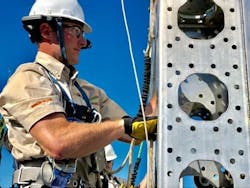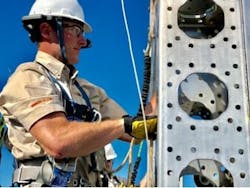Three ways assisted-reality wearables increase frontline worker safety
RealWear's Rama Oruganti
Today, industrial frontline workers must refer to workflows and equipment schematics while toiling long hours on factory floors, at offshore oil rigs, or in other hazardous environments. To get their work done more effectively, they are increasingly using popular meeting-collaboration apps like Microsoft Teams, Zoom, and WebEx to remotely communicate with customers, original equipment manufacturers and other subject-matter experts.
As more workers expect to collaborate remotely, demand for mobile devices that support collaboration applications has grown. This is especially true with business travel declining in light of the pandemic. For example, McKinsey reports that total global business travel expenses dropped by 52% in 2020.
Moving beyond the antiquated clipboard, frontline workers are relying on ruggedized tablets, laptops, and smart phones to run workflow, collaboration and other apps. However, it may be one step forward, two steps back—in doing so they are potentially risking injury, as these devices require them to keep their head down hands occupied with the device. In addition, these tools have been designed for use by office workers and consumers and, like texting while driving, do not allow a worker to maintain situational awareness as they use them.
Consider a construction worker who is holding a smart phone as he inspects metalwork on a new bridge; she does not have her hands free to grab a handhold to prevent her from falling. Or think of a technician who is looking at his tablet’s screen while he tries to fix a complex piece of machinery—he is going to be less aware of the dangerous equipment operating around him if he is studying a tablet.
Assisted-reality wearables are voice-activated, which allows workers to use them while keeping their hands free in hazardous environments.
These workers also often need to remove their personal protective equipment (PPE) to use these devices. For example, an oil worker who needs to swipe through pages in an electronic manual will often need to remove his safety gloves to do so.
Fortunately, industrial-strength assisted-reality wearables, purpose-built for industrial use cases, have emerged that allow frontline workers to use collaboration, workflow and other applications more safely than traditional smartphones, laptops and tablets. They do this in three meaningful ways: 1) by allowing workers to keep their hands free as they use these applications 2) by keeping their line of sight open so they can focus on work tasks while still being aware of their surroundings 3) by allowing workers to wear PPE even as they use these applications.
What is an industrial-strength assisted-reality wearable?
Industrial-strength assisted-reality wearables usually consist of a head-mounted system, camera, microphones, speakers, flashlight, and small display integrated into a new form factor: a ruggedized, voice-controlled, hands-free device that can be comfortably worn by a frontline worker on a hard hat for an entire shift.
Because these devices are voice-activated, workers can use them while keeping their hands completely free for the actual work, as opposed to tablets, smart phones and laptops. And thanks to the use of multiple microphones and advanced noise-cancelling software algorithms, these wearables can be used on the factory floor and in other high-noise environments.
Using these wearables, workers can join Teams, Zoom, and WebEx meeting with mentors, trainers, customers, suppliers and colleagues; they can read digital workflow, equipment schematics, and other technical information; they can take photos or video of equipment; they can do anything they would using a tablet, computer, or smart phone for in industrial setting—all while keeping their hands free, their field of view focused on their task, and their PPE securely in place.
Free hands, focused line of sight & full PPE
With an assisted-reality ruggedized wearable ready for enterprise use, workers can collaborate with a colleague or view an online manual while holding a tool in one hand and gripping a safety line or handhold with the other, reducing the chances that they might fall. In addition, with a very small screen that sits inside their field of vision without blocking their line of sight, the worker can focus more on the task they are doing than they would if they were switching their gaze between a screen and the task.
Wearables like these also deliver frontline workers immediate access to information with a quick glance down/glance up approach that provides them with a full line of sight on their work and better awareness of their surrounding environment.
Slim and lightweight assisted-reality wearables can be easily clipped onto hardhats and worn with other PPE, including vision, hearing and respiratory protection. Workers can also put these lightweight wearables on with their PPE on at the beginning of their shift or task and not remove their PPE when they need to access applications. For example, using just their voice they can start a Teams session with a colleague, review a workflow process, or access equipment schematics.
Human-centered design elevates, engages & empowers frontline workers
Assisted reality wearables improve worker safety because they are human-centered—designed from the ground up to put the frontline workers first (not their smartphone, tablet or laptop); that is, at the center of the next industrial revolution.
Rather than forcing workers to do their jobs in a new way, these solutions elevate frontline workers by empowering them to interact and engage with applications in a manner that allows them to work with efficiency, safety and precision.
In doing so assisted-reality wearables elevate frontline workers, delivering them the control and information they need to not just get their jobs done more safely, but also quicker and better than ever before.
Rama Oruganti, chief product officer at RealWear


